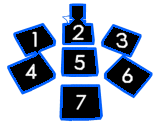

 In December 1995, about a year after the Saturn launched in Japan and only a few short months after the Saturn's launch in North America, Hitachi released the single most extreme console the world has ever seen. The HiSaturn Navi. Its feature list was enormous: slim profile, car adaptor, LCD screen, GPS Navigation, karaoke... No console before or since dared dream of including half these features, which is why to this day it is probably the rarest and most expensive post-NES console. In fact, even considering the piles of weird pre-NES hardware, the HiSaturn Navi still ranks as one of the most ridiculously expensive and elusive systems you're ever likely to see. As of this writing (2003/06/23) you can expect to pay over $1200 USD to get one of these in decent shape with a screen, and more if you get one in like-new condition with all the boxes and manuals intact. Totally ridiculous, and yet...  When Sega was creating the Saturn system they enlisted the help of several long-time partners - JVC provided the CD mechanism and Hitachi provided the dual SH-2 CPUs. As part of a co-branding or cross-licensing agreement, both of these companies produced their own variants of the Saturn hardware. Both JVC's V-Saturn and Hitachi's HiSaturn were merely coloured variants of the Sega Saturn, with no additional features or capabilities. All three manufacturers, Sega, JVC + Hitachi, released older oval-button systems and newer round-button systems, and none of these are particularly rare, but then Hitachi threw down the gauntlet.
When Sega was creating the Saturn system they enlisted the help of several long-time partners - JVC provided the CD mechanism and Hitachi provided the dual SH-2 CPUs. As part of a co-branding or cross-licensing agreement, both of these companies produced their own variants of the Saturn hardware. Both JVC's V-Saturn and Hitachi's HiSaturn were merely coloured variants of the Sega Saturn, with no additional features or capabilities. All three manufacturers, Sega, JVC + Hitachi, released older oval-button systems and newer round-button systems, and none of these are particularly rare, but then Hitachi threw down the gauntlet.
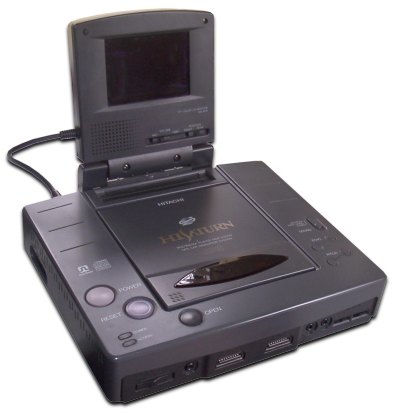
It beggars disbelief to this day. The Saturn was only a year old when Hitachi threw out the Sega mold and released a completely redesigned system jam packed with goodies. It's smaller than your average Saturn - about the same width and length, but almost a third shorter and it's nearly flat on top. It's considerably heavier because of the added components, even considering most of the power supply was made external. In addition to the standard Saturn ports (serial, AV + controller) it has two microphone inputs for karaoke use, a GPS antenna port, video and audio inputs, a TV-tuner port and a line-out port. This was all standard equipment. 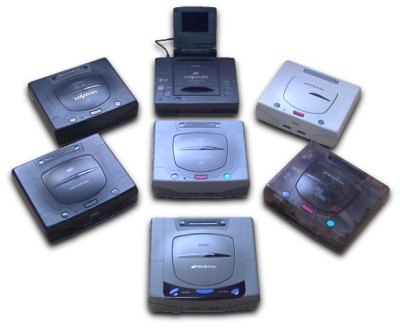 (click for larger)
Also accounting for the system's rarity are the production quantities: only two thousand HiSaturn Navi units were produced every month. Unconfirmed: I've been told the system was in production for only one month. Possibly then only 2,000 units were produced. 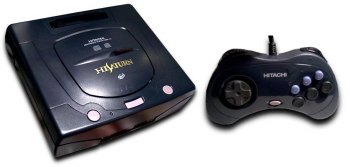 Normal HiSaturn + Pad (click for larger)  The LCD screen was released at the same time as the system, but only one thousand units per month were produced - half the number of systems. It was a backlit active-matrix TFT screen, a very expensive process at the time, with resolution, clarity and contrast surpassing any other console screen - equal in vibrancy but larger than the Turbo Express. It draws its power from the system, so no additional power supply is required. . It clips to the back of the system and plugs in with a short cable to the 'monitor out' port. When closed it sits flush with the CD door, and has quite a slim profile, when closed the system is approximately the same height as a normal Saturn. The screen is capable of displaying both interlaced and non-interlaced video. It has a sliding volume control, and one speaker, as well as tint + brightness controls and a Front/Rear switch, which serves a very secret purpose (I have no idea what).
The LCD screen was released at the same time as the system, but only one thousand units per month were produced - half the number of systems. It was a backlit active-matrix TFT screen, a very expensive process at the time, with resolution, clarity and contrast surpassing any other console screen - equal in vibrancy but larger than the Turbo Express. It draws its power from the system, so no additional power supply is required. . It clips to the back of the system and plugs in with a short cable to the 'monitor out' port. When closed it sits flush with the CD door, and has quite a slim profile, when closed the system is approximately the same height as a normal Saturn. The screen is capable of displaying both interlaced and non-interlaced video. It has a sliding volume control, and one speaker, as well as tint + brightness controls and a Front/Rear switch, which serves a very secret purpose (I have no idea what).


 A GPS antenna port and a GPS antenna/receiver were standard equipment. In-car navigation systems have been popular in Japan for a very long time, but I'm not sure to whom this particular system seemed a good idea. Installation of the power supply and GPS antenna were semi-permanent, as the former had to be tucked away carefully to avoid unsightly cable dangle, and the latter needed to be clipped to the handbrake. When installed you could use the system like any other navi. The screen showed your location overlaid on a road map, and you could zoom in or out, add locations, plot routes and leave 'bread crumb' trails. No navi software or boot disc was needed, to operate the navi you merely turned the system on with any Naviken compatible map CD in the drive, and the Navi mode started.
A GPS antenna port and a GPS antenna/receiver were standard equipment. In-car navigation systems have been popular in Japan for a very long time, but I'm not sure to whom this particular system seemed a good idea. Installation of the power supply and GPS antenna were semi-permanent, as the former had to be tucked away carefully to avoid unsightly cable dangle, and the latter needed to be clipped to the handbrake. When installed you could use the system like any other navi. The screen showed your location overlaid on a road map, and you could zoom in or out, add locations, plot routes and leave 'bread crumb' trails. No navi software or boot disc was needed, to operate the navi you merely turned the system on with any Naviken compatible map CD in the drive, and the Navi mode started.
 GPS Antenna port + VCD bay 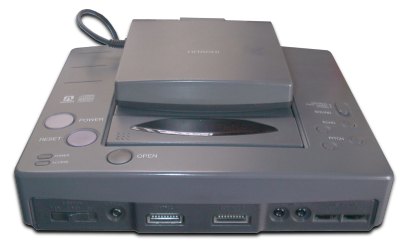 If you happen to own one and dare use it in the car, you can bypass this 'feature' by connecting the sensor cable to anything grounded.  Karaoke was absolutely huge in Japan. To say it was a phenomenon is a gross understatement. Every piece of stereo equipment featuered karaoke inputs. Portable CD players had CD+G capability and video output jacks, even the Sega CD system had a karaoke option. With the HiSaturn Navi, the karaoke features were built in, with two microphone ports and independant volume controls, as well as four buttons on top of the unit controlling Echo and Pitch. In addition, there was a control for voice cancellation or multiplexing on the top of the unit. These features are present in other Saturn models, but the buttons are software controlled and only accessible while playing music CDs or CD+Gs. With the HiSaturn Navi you can control the pitch or cancel voice for all audio output, a real laugh during gameplay, I assure you!
Karaoke was absolutely huge in Japan. To say it was a phenomenon is a gross understatement. Every piece of stereo equipment featuered karaoke inputs. Portable CD players had CD+G capability and video output jacks, even the Sega CD system had a karaoke option. With the HiSaturn Navi, the karaoke features were built in, with two microphone ports and independant volume controls, as well as four buttons on top of the unit controlling Echo and Pitch. In addition, there was a control for voice cancellation or multiplexing on the top of the unit. These features are present in other Saturn models, but the buttons are software controlled and only accessible while playing music CDs or CD+Gs. With the HiSaturn Navi you can control the pitch or cancel voice for all audio output, a real laugh during gameplay, I assure you!
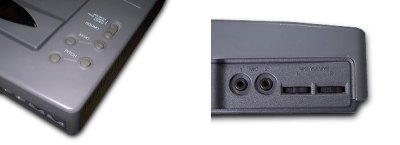 Sound controls + karaoke ports  The slim profile of the system made some extra demands for manufacturing, and because it was released relatively early in the Saturn's lifespan there was no newer, smaller chipset to use. To save space, most of the power supply was made external, but there's still part of it inside. There are two additional PCBs inside, one for the extra sound controls, and one for the GPS. There are many additional chips - video select, audio control, the GPS software, etc. It is fully region moddable like any other Saturn, and you can easily make a switchless mod for playing US or European games without cutting new holes. It has a VCD slot for the movie card, and it uses the same CR2032 battery for backup RAM. There is a cart slot, but the screen cannot be closed with a cart inserted, and the cart will block some of the screen controls.
The slim profile of the system made some extra demands for manufacturing, and because it was released relatively early in the Saturn's lifespan there was no newer, smaller chipset to use. To save space, most of the power supply was made external, but there's still part of it inside. There are two additional PCBs inside, one for the extra sound controls, and one for the GPS. There are many additional chips - video select, audio control, the GPS software, etc. It is fully region moddable like any other Saturn, and you can easily make a switchless mod for playing US or European games without cutting new holes. It has a VCD slot for the movie card, and it uses the same CR2032 battery for backup RAM. There is a cart slot, but the screen cannot be closed with a cart inserted, and the cart will block some of the screen controls.
  AV input + tuner port  I'm not certain the TV tuner was ever released. I've never seen one for sale, if it did reach store shelves it was in frighteningly limited numbers. The system manual makes reference to this unit as 'forthcoming' along with the never-released hard drive, and the keyboard and floppy drive which were released much later, and not by Hitachi. The HiSaturn Navi pad is the same as the other HiSaturn systems, which are in turn only cosmetically different than the Sega-branded units.
I'm not certain the TV tuner was ever released. I've never seen one for sale, if it did reach store shelves it was in frighteningly limited numbers. The system manual makes reference to this unit as 'forthcoming' along with the never-released hard drive, and the keyboard and floppy drive which were released much later, and not by Hitachi. The HiSaturn Navi pad is the same as the other HiSaturn systems, which are in turn only cosmetically different than the Sega-branded units.
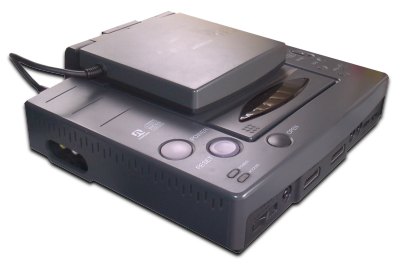
  Adding RGB output
Adding RGB outputImport modding Switchless mod info |
